Dealing with Invasives
Posted on Wednesday, August 21, 2013 · Leave a Comment
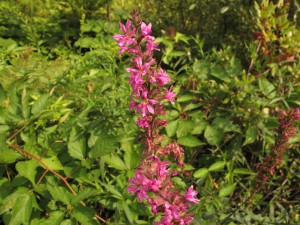
Purple loosestrife closeup
I’m sure you know purple loosestrife, even if you don’t know its name. It’s a big, tall clumping plant bearing bright pinkish-purple flowers and it’s appearing now in your neighborhood, especially in wet areas. What you may not know is that it’s an aggressive foreign invader that can out-compete many of our native species. It has been around for a couple of centuries – it came over, allegedly, in soil used as ballast in sailing vessels in the late 1700’s.
But if it grows well and it’s pretty, what’s the problem, you may wonder? A number of things. It’s a big plant that can dominate the landscape and shade out smaller, less vigorous native plants. A mature loosestrife can produce up to a million seeds, seeds that can be carried by streams to new locations. Wildlife can be negatively impacted. Many insects and birds depend on native plants for food and nesting materials- native plants that evolved with them. Invasives like purple loosestrife often do not meet their needs.
According to Barbara McIlroy of Etna, NH, who has been active in the movement to control invasive species, the number of bird and butterfly species present on properties that grow native species is much, much higher. “I’m converted,” she told me. “Grow natives. Period. The positive effect on the wildlife is dramatic.”
Unfortunately, it’s almost impossible to rid your property of purple loosestrife. These plants have amazingly tenacious roots. Before I knew better I tried digging out some large plants from a swampy area on my property. Yes, I got the plants out – but some of the roots broke off and re-sprouted. And by clearing out a space, I also opened up a new site for seeds to grow. If you have had purple loosestrife in the past, there are seeds waiting for a chance to germinate – like little time bombs.
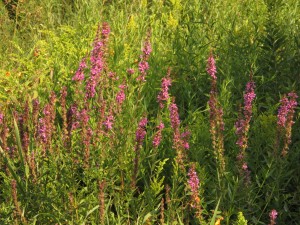
Loosestrife
But there is good news: two species of beetle (Galerucella calmariensis and G. pusilla) have been approved for and found effective in controlling purple loosestrife. These beetles cannot eliminate the loosestrife, but can reduce the numbers dramatically. Loosestrife is not a problem in Europe the way it is here, in part because it has natural enemies – the beetles. By introducing the beetles, an effort has been made to help Mother Nature keep loosestrife under control. Once established, they eat enough of the leaves and stems that the plants do not bloom. And theses beetles have been well tested: they will not eat your garden plants or valuable crops.
In 2001 Saint-Gaudens National Historic Site in Cornish, NH released two species of beetles to see if they could control the purple loosestrife that was taking over the wetlands at Blow-Me-Down pond. I met recently with Steve Walasewcz, who monitored the effort from 2001 to 2008. He explained that the beetles did not have an immediate effect. In fact, from 5.75 stems per square meter in 2001, the numbers increased to 10.5 by 2003. But then they declined each year until reaching only 1.05 in 2008 – a tenth the number of stems.
I went to the area where the beetles were released in 2001 and although there were a few blooming stems of purple loosestrife, there were very few. According to a report done for Saint-Gaudens NHS, it is believed that even low numbers of beetles prevent flowering; at higher numbers, “the beetles can strip the plants of its photosynthetic layer, resulting in high mortality in the winter due to a depleted starch reserve.”
Unfortunately, the beetles are not readily available for purchase. But for several years I have been experimenting with my own way of controlling the problem near my brook. Each year in early July I take pruners and cut back the plants to the ground. I identify them by their square stems that have a reddish color near the ground, and of course their leaves. Then a month later, I do it again – in essence, acting like a beetle. By cutting back the plants, few are able to bloom, greatly reducing the number of seeds spilling into my environment.
As a second step, I planted some big, tall native plants that I hoped would compete with the purple loosestrife: Joe Pye weed (Eupatorium purpureum) and Canadian burnet (Sanguisorba canadensis). I also added marsh marigold (Caltha palustris), which though not tall, is tough. These natives have given purple loosestrife a run for its money. Instead of filling 3 wheelbarrows with cut loosestrife in early July, I was able to get it all in one.
Purple loosestrife is just one of many invasive plants. If you see a new, vigorous plant show up on your property, try to learn its name and find out if it’s a problem elsewhere. Meanwhile, there is good news: scientists are working on biological controls for both Japanese knotweed (commonly called bamboo) and garlic mustard. In England, certain beetles are now well established to reduce the vigor of Japanese knotweed.
Henry Homeyer is the author of 4 gardening books and a new children’s fantasy-adventure about a boy and a cougar. His web site is www.Gardening-guy.com.
What To Do When Company is Coming
Posted on Wednesday, August 14, 2013 · Leave a Comment
I’ve got company coming this weekend, and I want my gardens to look nice. I can’t make them perfect, but here are some of the things I’m doing – and that you can, too, whether company is coming or if you just want to get on top of garden tasks.
First of all, I am getting rid of all the tall weeds. A flower bed with 4-foot tall weeds is much less attractive than a flower bed with the same number of short things creeping around the bed. So golden rod that towers over the daylilies is much more of a problem than 6-inch tall creeping Charlie that scurries around their base.
Now a big clump of goldenrod can be a fearsome opponent. It holds on fiercely. But if you are truly in a hurry, you can fix the problem – in the short term- by cutting it off with pruners or a sharp serrated knife. That makes it disappear to the casual viewer. Later, when you have more time, you can dig up that big clump of tenacious weeds with a shovel.
Next I am buying some plants to fill in spaces. Each year a few perennials die over the winter, and I try to replace them each spring and summer. But this year was so wet that I never got around to doing so. There are places where, I must admit, some flower beds have patches of pure weeds. Nothing but weeds. As I weed them out, I am discovering spaces where I can plant new things.
I recently was at a Farmers market and saw a beautiful purple-blue perennial known as a speedwell or veronica. (Veronica spicata). It was in full bloom and magnificent with 16 inch spikes of small flowers. I should have purchased three, but was unsure how much space (and money) I had, so I only bought one. Maybe next week there will still be some left and I can buy more. I had a nice spot in mind for it.

Veronica spicata
This is the time of year when daylilies are particularly lovely, so next I went to Cider Hill Gardens in Windsor, VT to look through their selection. I bought some nice ‘spider’ daylilies. These are a type that differs from standard daylilies by having longer petals that are spaced farther apart – almost like the legs on a spider. I planted them with the veronica – a very nice contrast.
You can divide most flowers almost any time of the year (except peonies, which should only be done in the fall). I had a big clump of a late fall-blooming clear yellow daylily that, over time, was being overshadowed (literally) by a multi-stemmed shrub known as common ninebark, a variety called ‘Diablo’. Diablo has dark purplish leaves and grows fast. Very fast. Each year- right after it blooms in June – I cut off about two feet from each stem to keep it under control. But each year the shrub sends up more stems from the ground, expanding its diameter. And so this wonderful daylily was being crowded.
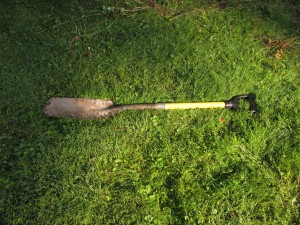
Drain spade
I used a drainspade to dig up that big daylily. This is a spade about 16 inches long and 6 inches wide. I pushed the spade into the soil at a 45 degree angle in 4 places around the perimeter. Each time it was fully inserted into the ground, I pushed down on the handle, lifting the clump a little. On the fourth and final push, I pried it out and carried it away.
At this time of year annuals are in short supply in most garden centers, but if you can find some, they are a great addition to the garden because most will bloom until frost. Just cut them back if they look ratty, and give them some liquid fertilizer.
Until recently, my window box by the front door was pretty pathetic. I yanked a lackadaisical dahlia and replaced it with a colorful pink ‘Superbena’. Superbenas are hybrids of annual verbenas that do very well in hot, dry locations like window boxes.
Potted plants can be used to spiff up the garden, too. I generally move all my potted plants outside in the summer, placing them on the north-facing deck. But when company comes, I am not above moving a few of the larger ones into the garden. I am careful not to put them in full sun, however, as they’ve been in a fairly shady location all summer and I could easily sunburn the leaves if I put them in too much sun. A nice clivia or papyrus in a decorative pot can be a nice addition to an otherwise drab location.
Last but least, mow the lawn the day before your mother-in-law or college roommate arrives. A well cut lawn is pleasing to the eye, especially if you use a push mower to go in all the corners, or use a string trimmer to do the edges. And it’s even okay to pay someone to do it. Then sit back, relax, and enjoy your property with your guests.
Henry Homeyer’s web site is www.Gardening-Guy.com. His is the author of 4 gardening books and a children’s book: Wobar and the Quest for the Magic Calumet.
Labor Savers
Posted on Wednesday, August 7, 2013 · Leave a Comment
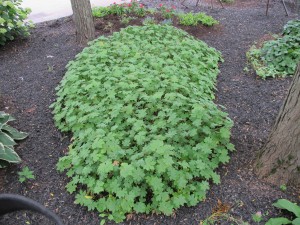
Geranium macrorrhizum
As I get older – I’m 67 – I sometimes wonder how long I will be able to keep on gardening at the level I do now. I have a large vegetable garden, fruit bushes and trees, many flower beds, a variety of decorative trees and shrubs – and some lawn. I have already accepted that it makes more sense to have a teenager mow the grass and to help me with some of the heavier drudgery of the garden. I am looking at ways to make less work for myself, and thought I might share a few labor-savers with you.
In the vegetable garden, mulch is my friend. It’s mid-summer, and some beds I have weeded more than once because I have not paid attention to my own dictum that mulching saves a lot of labor. But this has been a soggy summer, and there have been many days when I could not get in the garden because the ground was water-logged. And some days I almost could have kayaked down the pathways of my garden. So I did not get my mulching done early. Even when I could have mulched, I didn’t because soil looses more moisture when exposed to the sun, and I needed to let the soil dry out.
This past week I have made a real effort to weed the vegetable garden and put down mulch. My basic technique is to weed, then cover the area weeded with something to keep the sun from reaching weeds that surely will germinate. I like newspapers covered with straw or mulch hay. Six pages of this paper covered with straw will prevent most weeds and grasses from growing. This year I got some jute coffee bags to use for mulching the pathways, and I like them, too.
Weeds in walkways can spread to the beds by root or seed, so keeping them weed-free is a great boon to the tired or over-ambitious gardener. Last fall I planted grass seed in some rows, and mow it. But the width of the mower required that I space beds farther apart than I usually do. And it is awkward to get the mower around corners of rows. So it is not a perfect solution, though it looks great if you have the space to maintain nice mowed paths.
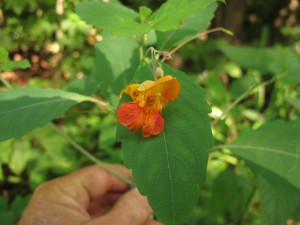
Jewelweed
It’s tough to find good weeders to help. But a teenager can do a nice job if you just teach her to identify and pull one or two particular species of troublesome weeds. So I have someone just working on jewelweed, also called touch-me-not (Impatience capensis). It is a tall weed with orange or yellow flowers and a hollow, watery stem. It generally grows in shade or part shade. It’s not a perennial so it has a relatively small root system that pulls easily.
Jewelweed’s other common name, touch-me-not, does not indicate any poisonous properties. It has to do with the fact that ripe seed pods have built-in springs that will propel seeds some distance. Lightly squeeze a pod, and good-sized green seeds go flying.
For the past decade I‘ve been ignoring touch-me-not because my grandchildren enjoy squeezing the pods. Doing so always provokes a giggle. But over time, more and more touch-me-not has appeared, and recently I declared war on it. The plants are just starting to bloom for me, so I must get them – now! This will not preclude having some plants next year or the year after, as most seeds of garden plants are good for 3 years (and weed seeds may last even longer). There must be plenty of seeds already in my soil. So Rule #1 of reducing work in the garden: Get rid of weeds before they scatter their seeds.
Some groundcovers can be great weed inhibitors in flower beds. Others spread so fast that they become weed-like themselves. If you want to plant groundcovers, be sure to weed the area well before planting them. Get not only the tops of your weeds, but their roots as well. Use a weeding tool that can get underneath a weed, loosen the soil, and lift the entire root system. I like the CobraHead weeder for that task.
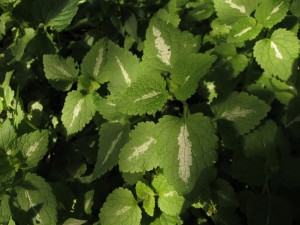
Lamium
There are lots of good groundcovers – too many to mention them all here. For dry shady areas, I like dead nettles (which I call by its scientific name, Lamium, because it is not related to stinging nettles). It has pink or white flowers reminiscent of snapdragons, and some varieties have nice silver and green leaves. It spreads and grows densely enough to keep many weeds from starting up under and between the plants.
Bigfoot geranium (Geranium macrorrhizum) is another good one. It’s not related to your mother’s potted red geranium (which is actually not a geranium but a Pelargonium). It makes a very dense mound of leaves a foot tall or more. It blooms in early summer, but I grow it for the foliage and because it shades out most things. And it will grow in dense, dry shade – or full sun.
Lungwort (Pulmonaria spp.) spreads by root in either sun or shade, as does lily of the valley (Convalaria majalis). I like the former, but find the latter a bit too aggressive to keep.
There are many ways to save labor, but most important of all is getting rid of any weed that is blooming now. It will save you labor later.
Henry Homeyer is a gardening consultant and the author of 4 gardening books. His Web site is www.Gardening-Guy.com.
Eight Flowers Great Flowers
Posted on Wednesday, July 10, 2013 · Leave a Comment
“I have a brown thumb” is a claim I hear on a regular basis, but one which I always dispute. There are no brown thumbs, only bad soil or plants living (and dying) where they should not be. Of course, any plant can die of thirst when first planted, and poor soils can keep them from thriving. But some plants are tougher than others, so this week I shall suggest eight plants that you can use in your garden with a very high probability that they will do well for you. Even very well. Even if you have a brown thumb. Just put them in good soil in the right amount of sun.
Daylilies (Hemerocallis spp.) are fool proof. I once left a clump of daylilies on the lawn in a relatively shady place. I had dug them up and fully intended to put them in the compost pile, but didn’t get around it right away. Before I knew it, they had rooted in – and were blooming!
Daylilies prefer full sun and good soil, but they’re not fussy. The old orange ones spread by root, as do the double orange ones. Most others just develop into bigger clumps every year. Daylilies produce flower stalks called scapes, and each scape will produce 3 to 9 buds; these buds bloom sequentially, each for just about a day – hence the name. Most daylilies come in shades of yellow, but dark reds and some pinky ones exist, too. A few re-bloom off and on all summer.
Evening primroses or sundrops (Oenothera missouriensis) are blooming for me right now, but they are not really primroses at all. The flowers are bright yellow cups on 18 to 30-inch stems that flower – and spread – cheerfully. They spread by root and by seed, and might be thought to be thugs, except they pull easily and are pleasant. They will bloom in full sun to part shade, and are not fussy about their soil.
Peonies (Paeonia spp.) These beauties are mostly done for the season, though a few late bloomers might still be blooming. They love full sun and rich soil, but will still bloom in part shade and even in dry, sandy soils. Their roots are big, fleshy tubers that go deep down into the soil, so I recommend digging a much bigger and deeper hole for a peony than for other plants. Enrich the soil with composted cow manure, rotted leaf mulch or other organic products, especially some organic fertilizer.

Bee Balm
Peonies grow from buds or “eyes” that develop each year beneath the soil surface. If you plant a peony too deeply and cover up the eyes with more than an inch of soil, the plant will not bloom after the first year. Other than that? Success is guaranteed. I have a peony that my grandmother Lenat planted – and she died around 1953. My mother grew it, now I have it. I shall leave it to one of my grandchildren. Peonies are forever.
Pink Mallow (Malva alcea). Some fancy gardeners turn their noses up at pink mallow, but I love it. It grows 3-5 feet tall and produces a bounty of pink blossoms that vaguely resemble single roses- but up to 3 inches in diameter. It has a deep tap root so it does not move easily, but seed-grown “volunteers” show up around my garden. Full sun to part shade. It is a short-lived perennial, but has plenty of “babies” so you will always have some.

Rudbekia ‘Prairie Sun’
Black-eyed Susans (Rudbekia spp.) There are dozens of species of this joyful summer flower. I grow a variety called ‘Prairie Sun’ in my hot, dry front walkway, and it blooms all summer – but, truth-be-told, often die in winter. No matter, I’ll buy it again and again. One of my favorites is a fall-season bloomer with delicate flowers, Rudbekia subtomentosa ‘Henry Eilers’.
Hostas (Hosta spp.). These are primarily shade plants grown for their lovely leaves. If there is too much sun on them, the leaves will scorch and turn yellow. A few kinds will bloom with tall flower spikes, but others have blossoms that are not of much interest. Hostas do best with rich soil, but will grow in almost any soil. I have hostas from under 2 inches tall to more than 30 inches tall, and a variety of greens, some with blue or yellow tinges.
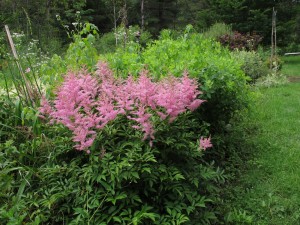
Astillbe
Astillbes (Astillbe spp.). These are primarily sold as shade plants, but I grow them in both full sun and partial shade. The key is this: the more sun there is, the more moisture is needed. They bloom in great plumes of tiny florets in pink, white and dark red. They appreciate rich, organic soil, so improve the soil before planting.
Bee Balm (Monarda didyma). Bee Balm displays nice clumps of red or pinkish tubular flowers that are arranged in whorls atop 3-4 foot stems. In the mint family, they are fragrant and clumps spread by root – sometimes too vigorously. But extra plants are easily pulled. Grow them in morning sun in ordinary garden soil. All day sun in dry, sandy locations will not lead to happy plants.
You don’t have to be born a gardener. Just follow the directions on the plant tags – or my articles – and be sure to add compost to the soil before planting in a nice, big hole. You’ll soon have a green thumb.
Henry Homeyer can be reached at P.O. Box 364, Cornish Flat, NH 03746 or henry.homeyer@comcast.net. His Web site is www.Gardening-guy.com.
Filed under Article · Tagged with astilbe, bee balm, day lilies, easy to grow flowers, eight great flowers anyone can grow, evening primrose, flowers for new england, gardening guy, Henry Homeyer, peonies, rudbeckia prairie sun
Selecting and Training Flowering Trees
Posted on Thursday, May 23, 2013 · Leave a Comment
This has been a great year for flowering trees and shrubs. My Merrill magnolia had many hundreds of white blossoms in late April.
The crabapples everywhere put on a spectacular display this year. My fothergilla (a shrub with great fall leaf color) is in bloom now with its tidy white bottle-brush flowers. My ‘Olga Mezitt’ rhododendron (one of the parents of the popular PJM rhodie) is looking great and my wild azaleas are getting ready to bloom. And now the lilacs are blooming for me and I am overwhelmed with the large purple, blue, white and pink panicles (clusters of flowers). Spring has definitely sprung.
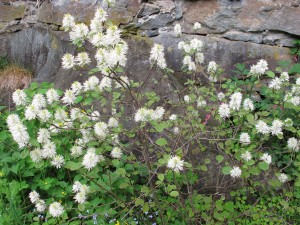
Fothergilla
All these blooms this year will certainly encourage many gardeners to buy trees and shrubs and plant them. That’s a fine idea, but if you plant now, please remember that you must keep watering them all summer if we don’t get an inch or more of rain per week. When August comes around it will be easy to have your new tree dehydrate if you get lazy or forgetful.
New trees and shrubs need a year or more to grow roots sufficient for their needs if we get hot, dry weather. So if you are forgetful or will be doing lots of traveling, you might want to hold off on planting a new tree until fall, which is also a good time for planting. Fall is cooler and more likely to be rainy.
I like to buy flowering trees and shrubs when they’re in bloom. That allows me to see the color and check out the fragrance. But there is more than just the flowers to consider when selecting a good crabapple or magnolia. Let’s start with size and price. Bigger
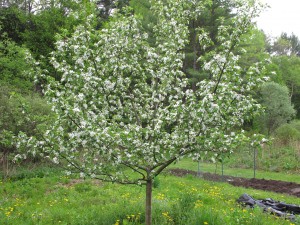
Nicely pruned apple tree
is not necessarily better. If you are on life support and don’t expect to be around in 5 years, sure, buy the biggest tree you can afford. But be aware that a bigger tree is not only more expensive – it is also harder to plant and takes more water and care. A bigger tree may have a smaller proportion of its root system intact after being dug up and put in a pot than a small tree. I like to buy smaller specimens and then train them to be a nice shape. That’s harder to do on a larger tree.
I recently visited a nice new nursery run by Henderson’s Tree Service on Rte 14 in Hartford, Vermont. There I chatted with my friend Sylvia Provost who is co-owner of the business. I asked Sylvia what she would look for if purchasing a crabapple for herself. Without a moment’s hesitation she responded. “Structure,” she said.
What Sylvia was talking about is the shape of the tree and the placement of the branches. Fruit trees produce best on branches that leave the trunk at a right angle or are aiming just slightly upward. Branches that shoot straight up are not usually good fruit and blossom producers.
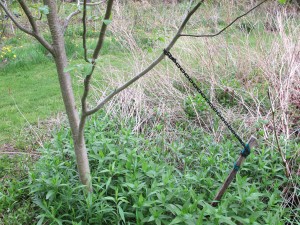
Changing the angle of a branch
And although Sylvia noted that you can train a tree to be the shape you want, it is easier to start with something that is closer to your ideal before you start training. So, for example, Sylvia said that if you have a swimming pool some distance from your patio, you should choose a tree that has an open format, one that you can see through – and see what is happening at the pool. Conversely, if you have nosy neighbors and want to screen their view of your patio, you might select a tree that has a full, dense arrangement of branches.
Generally, pruning a tree should begin in the second year of its life at your home. I often see apple and crabapple trees that have very low branches. I like to prune off those low branches to make it easy to mow around, and to have a nicer look. And if two branches are both striving to be the “leader” or the dominant, tallest stem, I remove one. And although most books say you should prune fruit trees in March or April, you can safely make a few judicious cuts now to train your tree.
You may train branches to grow at different angles by weighing them down – if you do so soon. This is an activity for spring, starting before the new layer of cambium growth has occurred. You can drive a stake into the ground and tie a branch to it for the next 2 months. A branch the diameter of a finger can weighed down by hanging a plastic pop bottle on it, then filling it with water until it bends to the correct angle.
Chris Wilson of the EC Brown Nursery in Thetford, Vermont suggested that when buying a tree, look at leaf color – leaves should be green, not tinged with yellow. He also suggested making sure the tree has branches on all sides, and that the bark has not been damaged.
So if you’ve delighted in the flowers on trees in your neighborhood this year, go get one or more. Study several specimens to find the best one. And just remember to water all summer long!
Henry Homeyer is a gardener and garden designer living in Cornish flat, NH. His Web site is www.Gardening-Guy.com.
Filed under Article · Tagged with EC Brown Nursery, flower crabapple tree, fothergilla, gardening guy, growing fruit trees, Henderson's Fine Gardening, Henry Homeyer, how to prune a tree, how to purchase fruit trees, hydrangeas, merrill magnolia, Olga Mezitt rhododendron, pruning trees, training tree branches
Attention Lazy Gardeners: Asparagus is a (Nearly) Free Ride
Posted on Wednesday, May 30, 2012 · Leave a Comment
As I am sure you know, once upon a time there were three little pigs. One built his house of bricks, one of sticks, and the lazy one built a house of straw. I forget the details, but I think the lazy one got eaten by the wolf – a moral for all kids and gardeners. Work hard, survive. But one exception to that rule is the asparagus patch. Each year you can have delicious food relatively work-free.
Okay, I exaggerate. There is considerable work in starting an asparagus patch, and a certain amount of work in keeping it weed-free. But it should come back reliably, year after year. So plant it well and keep it mulched to hold down weeds, and you can garner rewards year after year.
Twenty-five plants is a reasonable number of plants for a family of four, or for two people with my appetite for those sumptuous green spears. Asparagus needs rich soil with lots of nutrients, so have a good supply of compost or aged manure and some slow release organic fertilizer at planting time.
Get a soil test done before you plant, or get at least get a kit that will tell you the pH. Asparagus does best with a near neutral pH, in the range of 6.5 to 7.5. If your pH is less than 6.5 you will need to add limestone to “sweeten” the soil. The test kit will tell you how much limestone you need.
Before planting, dig out all weeds and especially grasses. Rototilling does not kill weeds and grasses, it just hides them. And they will come back to plague you for years. So weed well.
Because asparagus lasts for many years, it is important to enrich the soil more than you would for annual veggies like tomatoes or lettuce. In the old days –back when I was a kid – asparagus beds were dug deep, and manure was worked into the soil down to a depth of 18 inches. Asparagus roots were planted in a trench with the crown (where the roots originate) planted a foot deep and 18 inches apart.
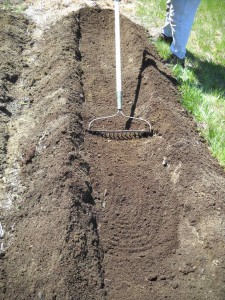
Preparing Asparagus bed
Current thinking is that asparagus still needs good loose soil, but that the crown only need be planted 6 inches below the soil line. Using a hoe or shovel, create a trench 9 to 12 inches deep and 12 to 18 inches wide. Then loosen the soil in the bottom of the trench with a spading fork. Space rows 2 feet or more apart.
Plan on working in 4-6 inches of aged compost into the soil down at the depth where the roots will be, and in the soil you will use for backfilling the trench. Don’t skimp, even if you have good soil. Work the compost in with a spading fork or shovel. A rototiller would also do the job, but can adversely affect soil tilth or texture if done when the soil is too moist. And rototilling disturbs microorganisms and earthworms in the soil.
I also like to broadcast a generous dose of Pro-Gro or other slow-release organic fertilizer everywhere in the planting trench and mix it in. A quart yogurt container of organic fertilizer is fine for a dozen plants. Azomite, a mineral mix that provides micronutrients is a good additive, too. Green sand is an organic source of potassium and micronutrients from the sea. All of the above should be available at your local feed-and-grain store or garden center.
Asparagus roots are now sold that are all male – generally anything that has the word ‘Jersey’ in the name is all male (Is New Jersey a macho state?). ‘Martha Washington’ is the classic asparagus variety, but it has male and female plants, so they produce seeds – and little seedlings. This is not good. You don’t want extra seedlings growing in your patch, as they will compete with your plants for water and nutrients, just like weeds. Of course, you can pull the seedlings growing under Martha, and re-plant them elsewhere, but that sounds like work to me.
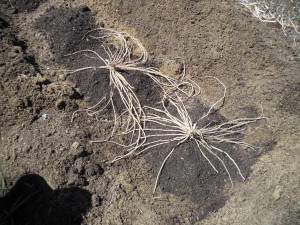
Asparagus planting
In the bottom of your trench build mounds of soil/compost mix. Drape the roots over the mounds with the crown sitting on top the mound. If the roots are longer than your trench is wide, swirl the roots around the mound a little. Then gently backfill your trench (or hole, if you did individual holes instead of a trench). Just an inch or two of soil is all that is required at the start. As the season progresses and the sprouts grow, add more soil/compost mix. By the end of the summer your plants should have 6 inches of soil over the crown.
A few recommendations: Have patience. Don’t pick any spears this year. Next year, just take one or two stalks per plant. Each year, take more – but never pick for more than 4 weeks. Taking too many spears will draw down their reserves and weaken the plants.
Keeping your asparagus patch well-weeded is important. Wood sides to an asparagus bed can help keep out creeping grasses, or you can dig a little moat around the bed to keep grasses from creeping in. Mulching with 6 pages of newspaper and 4 inches of straw will help keep down weeds and will hold in moisture.
Even if you are the quintessential third pig when it comes to gardening, don’t be lazy when planting asparagus. A little extra work now getting out weeds and working in healthy soil additives will pay you back many times over. Bon Appétit!
Henry Homeyer is a gardening consultant and author living in Cornish Flat, NH. His Web site is www.Gardening-guy.com.
Holiday Gifts for the Gardener
Posted on Wednesday, December 7, 2011 · Leave a Comment
Gardeners are easy to shop for. We all need the practical (rubber-palmed stretchy garden gloves, watering wands, garden scissors, plant labels) and appreciate the whimsical (a nice garden gnome to surprise the grandkids). Gardening books keep us occupied during the long winter nights, and garden tools keep us dreaming of perfect peonies. Here are some suggestions for the gardener you love.
This year I discovered Tubtrugs. They are multipurpose, brightly colored, somewhat flexible containers made of food grade plastic that I like to fill up with weeds. I also use them when harvesting veggies or carrying hand tools; you can fill one with water to soak a dry potted plant or wash a small dog. They are easy to carry – handholds are built in. They come in 4 sizes from about 4 gallons to about 20 gallons. I have the 2 smaller sizes, which cost $11-14. Available at your local garden center or from www.tubtrugs.com.
As much as I don’t like plastic, I found another plastic product that is very handy: an Oxo brand watering can. As with other Oxo products, I find it not only functional, but handsome – and these come in a variety of colors. I like that the spout lets you see the water level inside when filling it up, and it rotates for storage (snuggling up, sort of, against the reservoir). The rose, which breaks the stream of water into a spray, is very fine for watering delicate plants, but I often just pull that off and water directly from the slender spout. They come in 2 sizes: 2 gallon ($28) and an indoor model that is just 3 quarts ($18). Available locally or on line.
Each year I have to tout my favorite weeding tool, the CobraHead Weeder, as it works so darn well, and I have met so many gardeners that just love it. It is a single piece of steel with a small, eye-shapede head and a curved handle. It has a nice bright blue, recycled plastic handle. It gets under weeds to pull from below while I tug on the topside; I use it when planting, too, stirring up the soil and teasing out grass roots. I like that it serves lefties as well as righties, and is light enough to please elderly weeders as well as big lunks like me. Cost? About $25. Available locally or at www.cobrahead.com or 1-866-962-6272.
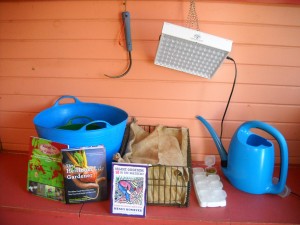
Holiday Gifts for the Gardener
Books help get gardeners through the winter. We read and plan when we can’t weed and plant. I recently got a very handsome, glossy-photo book by Jeremy and Emily Gettle, co-owners of Baker Creek Heirloom Seeds. He is quite a character – he started at age 3 and was growing 2 acres of vegetables by age 18. He started his own seed company when he was just 22 years old and now 33, he has quite a large operation – and a book.
The book, The Heirloom Life Gardener: the Baker Creek Way of Growing Your Own Food Easily and Naturally, is interesting and full of personal stories and anecdotes by Jeremy. He is opinionated, which I like, too. Best of all, it has a directory of garden vegetables that not only tells you how he grows them, but guides you to save your own seeds. It’s $30 in hardcover.
Another book I like is Ancestral Plants: A Primitive Skills Guide to Important Edible, Medicinal and Useful Plants of the Northeast by Arthur Haines. This is a fascinating technical book for survivalists, among others. It tells you not only about edible and medicinal plants, but which ones to use for making your own rope or are useful when starting a fire without matches. Haines is young (forty-one), and a serious scholar, having just written a 1,000 page taxonomy of plants.
Haine’s book gives information available in no other book I have found. So, for example, he tells you to eat eastern prickly gooseberries one at a time so that the crushing of the berry is done with teeth, not the palate (to avoid the prickles), and that it is high in Vitamin C, antioxidants and pectin so it can easily be made into jam. Each plant has at least 2 excellent color photos and 2 pages of text. $23 in paper available locally, or from www.anaskimin.org.
Each year I find some nice products from Gardeners Supply Company in Burlington, VT (www.gardeners.com or 888-833-1412). This year I like their pesto storage cubes for freezing pesto or tomato paste. They have attached lids, and fit into trays for storage. At $7.95 for 8 cubes they are a good gift. I also like their Root Storage Bin which costs $34.95. It is a sturdy wire bin lined with jute fabric designed to hold carrots, beets etc. in a cool dark cellar. It allows you to layer moist sand in it, keeping the veggies from drying out. It fits in a fridge I use for storing veggies. They also sell the Tubtrugs mentioned above. Since Gardeners Supply is an employee-owned company that supports lots of good causes, I enjoy supporting them, too.
I’ve been using LED lights this fall to pamper my houseplants, and I find my plants are much healthier this year. Best of all, for 42 watts of electricity I am getting the equivalent of 250 watts of light, and the spectrum of light, the company says, is just right for making plants happy. I got mine from Sunshine Systems (www.sunshine-systems.com or 866-576-5868). Each unit costs about $150 and is suitable for illuminating 5 square feet of plant space. The lights are designed to let you connect several together, which is handy.
Lastly, as an author I would be remiss if I didn’t mention my own new book: Organic Gardening (Not Just) in the Northeast: A Hands-On, Month-by-Month Guide (Bunker Hill Publishing). It’s a collection of my best writings from the past 10 years, organized around the calendar year. It’s $17.50 from your local bookstore or from my website (www.Gardening-guy.com).
So give Santa a hand. Go get something nice for the gardener in your family. And remember to try buying local first: local bookstores, local garden centers – only buy on the Web as a last resort! And Happy Holidays to you all.
Henry Homeyer is the author of 4 gardening books. His Web site is www.Gardening-guy.com.
Using Found Plant Material to Decorate the Holiday Home
Posted on Thursday, December 1, 2011 · Leave a Comment
Once again, my garden is just about out of steam. Winter is upon us – not by the calendar – but with temperatures dropping into the low 20’s recently, I say it’s winter. It’s no longer possible to step outside and fill a vase with my own flowers. The only flowers still blooming are my intrepid Johnny Jumps-Ups (Viola tricolor). At one time or another they have bloomed for me every month of the year. That’s right, if we have a January or February thaw, the Johnny’s may well bloom. But still, I long for more variety.
As a freelance writer, I don’t have a big budget for cut flowers. But I do believe in buying a few stems to brighten the table on a regular basis. Recently I bought 3 stems of what are called “spider mums’ for a total of just $4.50. I then went outside to see what I might add to these flowers to fill up the vase. There is a remarkable amount of useable material outside, both in the garden and in the wild.
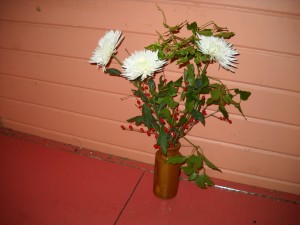
Winter Arrangement With Mums
The general rule of thumb is that an arrangement should be two to three times the height of the vase. I selected an 8-inch vase, and cut the mums down to about 20”. The mums are white, so to add color I cut some stems of winterberry (Ilex verticillata). Winterberry is our native deciduous holly plant that flaunts bright red berries at this time of year. They are commonly sold landscape plants but also grow wild in wet places along the road. They grow 4-12 feet tall; the stems I cut were about 3 feet long, and branched.
I decided to cut off 12-inch side shoots and use them to form the lower portion of the arrangement. I put the tall mums in the center of the vase and their green leaves added a contrasting color and filled out the space between the blossoms and the berries. I also added a section of a clematis vine for more greenery.
At this time of year I crave greenery, so I was delighted to notice nice glossy leaves on my fall-blooming clematis (Clematis paniculata), a vine that I grow on a trellis. I had never before picked a vine to use in a vase, but it worked well. Vines, I just discovered, are wonderful in an arrangement: they are flexible and can be woven through stalks of tall stiff flowers or shrubs.
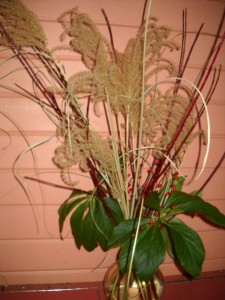
Winter Arrangement Using Found Plants
Next I went outside to collect things that are totally free for a second arrangement. I grow Lenten Rose (Helleborus orientalis), an early spring-blooming plant with glossy, evergreen leaves. Each leaf consists of 5-9 oval leaflets attached to a central point; each group of leaflets is a foot or so in diameter. By spring this year’s leaves will be ratty looking, but now they still looked good. I selected 4 leaves to establish a visual base for the arrangement. They looked good in the vase for about 5 days.
Lacking Lenten rose, I could have used white pine branches for some greenery, or balsam fir or spruce branches. I know better than to use Canadian hemlock in a vase, even though I have plenty of it, because it drops its short, soft needles after just a few days.
Next I cut six 24-inch stems of redosier dogwood (Cornus sericea) and added them to the 10-inch tall, wide-mouthed vase. I grow this shrub mainly for its look in winter. The first-year stems turn bright red in winter, standing out proudly above the snow. Second-year stems (and older) turn a darker, brownish color, so cutting some stems each year keeps the shrub looking at its best. Redosier dogwoods prefer moist soil, but will grow almost anywhere – including alongside the road.
Lastly, I cut stems of a tall decorative fountain grass (Miscanthus sinensis) and added them to the arrangement. Decorative grasses have become very popular in the landscape design business, but not all perform well after year one. They generally like lean, well-drained soil and my soils tend to be rich and moist, but some years I have some very dramatic 6-foot tall plants that look good for most of the winter. I have plenty right now.
If you don’t have a decorative grass with seed heads to use in an arrangement, you might be tempted to pick some stems of the common reed whose Latin name is Phragmites australis. It is commonly seen alongside the road in wet places. It can grow to 10 feet tall, and is very dramatic. The pretty part of the plant consists of big fluffy seed heads (on tall stems). But if you do use it, don’t throw the seeds in your compost pile because the plant can be invasive. Burn the seed heads when done with the arrangement – even though I’ve read that that the plants spread mainly by root.
So don’t despair if your flowers have all gone away. Just go outside with your scissors and a pair of pruners. There are plenty of other interesting stems that are free for the taking.
Henry Homeyer’s new book is called Organic Gardening (not just) in the Northeast: A Hands-On, Mo nth-by-Month Guide. His Web site is www.Gardening-Guy.com. Reach him by e-mail at henry.homeyer@comcast.net




















